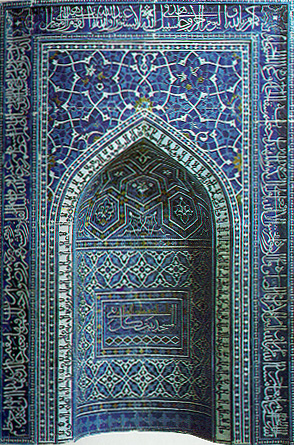

A Persian mihrab or prayer niche, 1354, now in the Metropolitan Museum of Art: *ZOOM access*
Source of above image: http://www.humanities.ccny.cuny.edu/history/reader/mihrab.htm
(downloaded Dec. 1999)
"Mihrab, 1354. Iranian. Attributed to Isfan, Iran. Mosaic of monochrome-glaze tiles on composite body set on plaster. H. 11 ft. 3 in. (343.1 cm), W. 7 ft. 6 in. (288.7 cm).
Description: The most important element in any mosque is the mihrab, the niche that indicates the direction of Mecca. Because it functions as the focal point in prayer ritual, its decoration was executed with great skill and devotion. This example from the Madrasa Imami in Isfahan, founded in A.H. 755/A.D. 1354, is composed of a mosaic of small glazed tiles fitted together to form various geometric and floral patterns and inscriptions. The inscriptional frieze in muhaqqaq script containing sura IX:14–22 from the Qur'an runs from the bottom right to the bottom left; a second inscription, in kufic script, with sayings of the Prophet, borders the pointed arch of the niche; and a third inscription, in cursive, is set in a frame at the center of the niche. The bottom of the niche, just below the central inscription, and a substantial part of the beginning and end of the main inscription were restored by skillful potters in Isfahan in the mid-1920s.
The inscription in the outer panel is a saying from the Qur'an referring to the duties of the faithful and the heavenly reward awaiting those who build mosques. The rectangular panel at the back of the niche contains the words 'the mosque is the house of every pious person'."
== Indian Routes index == Indian Routes sitemap == Glossary == FWP's main page ==